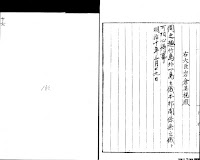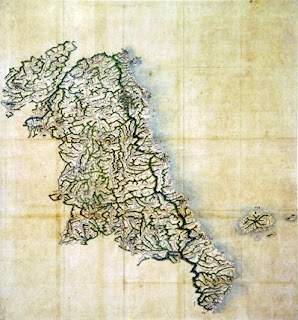D(02左)右大臣・参議の決定文書 明治10年3月20日
「太政官」の罫紙
 立案 第二十号 同廿七日来 「牟田口」印
立案 第二十号 同廿七日来 「牟田口」印明治十年三月廿日
大臣 「岩倉」具視印 本局 「土方」印、「巌谷」印)
参議 「大隈」重信印、「寺島宗則」印、「大木」喬任印
卿輔(印等なし)
別紙、内務省伺、日本海内竹嶋外一嶋地籍編纂之件。(Cをさす)
右ハ、元禄五年、朝鮮人入嶋以来、旧政府、該國ト往復之末、遂ニ本邦関係無之、相聞候段、申立候上ハ、
伺之趣、御聞置、左之通、御指令相成可然哉、此段相伺候也。
御指令按
書面(→「伺之趣」に朱字訂正)竹島外一嶋之義、本邦関係無
之義ト、可相心得事
(02右)
E
(朱字)明治十年三月廿九日 朱印 誰の印? これ非常に重要
・・・・・・・・・・・・・・・・・・・・・・
B(03左~04右)
島根県→内務卿 地籍編纂の伺い 明治9年10月16日
これ以下はすべて「内務省」の罫紙
「日本海内、竹島外一島、地籍編纂方、伺」
御省、地理寮官員、地籍編纂莅檢之為、本縣巡回ノ砌、
日本海中ニ在ル竹島調査ノ儀ニ付キ、別紙「乙第二十八号」之通、照會有之候處、
本島ハ、永禄中發見之由ニテ、故鳥取藩之時、元和四年ヨリ、元禄八年マテ、凡七十八年間、同藩領内、伯耆國米子町之商、大谷九右衛門・村川市兵衛ナル者、旧幕府ノ許可ヲ経テ、毎歳渡海、島中ノ動植物ヲ積帰リ、内地ニ賣却致シ候ハ、已ニ確証有之、今ニ、古書旧状等持傳候ニ付、別紙「原由ノ大畧」、「圖面」共、相副、不取敢、致上申候。
今回、全島實檢之上、委曲ヲ具ヘ、記載可致ノ處、
固ヨリ、本縣管轄ニ確定致候ニモ無之、且、北海百余里ヲ懸隔シ、線
 路モ不分明、尋常帆舞船等ノ能ク往返スヘキニ非ラサレハ、
路モ不分明、尋常帆舞船等ノ能ク往返スヘキニ非ラサレハ、右大谷某、村川某カ傳記ニ就キ、追テ、詳細ヲ上申可致候。
而シテ、其大方ヲ推按スルニ、管内隠岐國ノ乾位ニ當リ、山陰一帯ノ西部ニ貫附スヘキ哉ニ相見候ニ付テハ、本縣國圖ニ記載シ、地籍ニ編入スル等之儀ハ、如何取計可然哉。
何分ノ御指令相伺候也。
縣令佐藤信寛代理 島根縣参事 境二郎
明治九年十月十六日
内務卿 大久保利通 殿
・・・・・・・・・・・・・・・・・・・・
A(04左)内務省地理寮→島根県地籍編製係照会 明治9年10月5日
そもそもの始まり。
乙第弐拾八号(朱字 貼紙)
御管轄内、隠岐國某方ニ當テ、従来、竹島ト相唱候孤島、有之哉ニ相聞、固ヨリ、舊鳥取藩、商船往復ノ線路モ有之趣、
右ハ、口演ヲ以テ、調査方、及御協議置候儀モ有之、
加フルニ、地籍編製、地方官心得書、第五條ノ旨モ有之候得トモ、
尚為念、及御協議候條、右五條ニ照準、而テ、舊記古圖等、御取調、本省ヘ御伺相成度、此段、及御照会候也。
明治九年十月五日 地理寮十二等出仕 田尻賢信
地理大属 杦山栄蔵
島根縣 地籍編製係 御中
・・・・・・・・・・・・・・・・・・・・・・・・・・・
B(島根県→内務省)の添付書類「原由ノ大畧」
(05左~08右)
 磯竹島、一ニ竹島ト稱ス。隠岐國ノ乾位、一百二拾里許ニ在リ。周回凡十里許。山峻険ニシテ、平地少シ。川三条在リ。又瀑布アリ。然レドモ、深谷幽邃、樹竹稠密、其源ヲ知ル能ハス。
磯竹島、一ニ竹島ト稱ス。隠岐國ノ乾位、一百二拾里許ニ在リ。周回凡十里許。山峻険ニシテ、平地少シ。川三条在リ。又瀑布アリ。然レドモ、深谷幽邃、樹竹稠密、其源ヲ知ル能ハス。唯、眼ニ觸レ、其多キ者、
植物ニハ、五鬣松 紫稱檀 黄蘗 椿 樫 桐 雁皮 栂 竹 マノ竹 胡蘿蔔 蒜 款冬 蔉荷 独活 百合 牛房 茱萸 覆盆子 虎杖 アラキパ。
動物ニハ、海鹿 猫 鼠 山雀 鳩 鴨 鶸 鳧 鵜 燕 鷲 鵰 鷹 ナヂコアナ鳥 四十雀ノ類。
其他、辰砂、岩緑青アルヲ見ル。
魚貝ハ、枚挙ニ暇アラス。就中、海鹿、鮑ヲ物産ノ最トス。
鮑ヲ獲ルニ、夕ニ竹ヲ海ニ投シ、朝ニコレヲ上レハ、鮑枝葉ニ着クモノ夥シ。其味絶倫ナリト。
又、海鹿一頭、能ク數斗ノ油ヲ得ヘシ。
(06右)
 次ニ一島アリ。松島ト呼フ。周回三十町許。竹島ト同一線路ニ在リ。隠岐ヲ距ル八拾里許。樹竹稀ナリ。亦魚獣ヲ産ス。
次ニ一島アリ。松島ト呼フ。周回三十町許。竹島ト同一線路ニ在リ。隠岐ヲ距ル八拾里許。樹竹稀ナリ。亦魚獣ヲ産ス。(「松島」に言及しているのは、ここだけ)
永禄中、伯耆國會見郡米子町商、大屋(後大谷ト改ム)甚吉、航シテ越後ヨリ歸リ、颶風ヲ遇フテ、此地ニ漂流ス。遂ニ、全島ヲ巡視シ、頗ル魚貝ニ富ルヲ識リ、歸國ノ日、検使安部四郎五郎(時ニ幕名ニ因リ米子城ニ居ル)ニ、彼趣ヲ申出シ、以後、渡海セント請フ。
安部氏、江戸ニ紹介シテ、許可ノ書ヲ得タリ。
實ニ、元和四年五月十六日ナリ。
従伯耆國米子、竹島、先年舩相渡之由候。然者、如其今度致渡海度之段、米子町人 、村川市兵衛・大屋甚吉申上付テ 達上聞候之處、不可有異儀之旨被仰出間 被得其意渡海之儀 可被仰付候。恐々謹言。
(06左)
五月十六日 永井信濃守 尚政
井上主計頭 正就
土井大炊頭 利勝
酒井雅楽頭 忠世
松平新太郎殿
當時 米子同町ニ、村川市兵衛ナル者アリ。大屋氏ト同シク、安部氏ノ懇親ヲ得ルカ故ニ、両家ニ命セラル。然レトモ、本島ノ發見ハ、大屋氏ニ係ル。
幕府、遠陬ノ地、本邦版圖内ニ入ルヲ称シ、船旗等ヲ與エ 殊ニ登営謁見セシメ、屡、葵章ノ服ヲ給ス。後 甚吉、島中ニ没ス。[墳墓、今尚 存スト云フ]。
元禄七年甲戌ニ至リ、朝鮮人上陸スル者、若干ナリ。ソノ情、測ル可カラス。且、船中人數ノ寡少ナルヲ以テ歸リ、是ヲ訴フ。
明年 幕命ヲ得、武器ヲ載セテ到レハ其人恐レテ遁レ去ル。残ル者ニ二人 [アヒチヤン トラヱイ]アリ。即チ捕縛シテ歸ル。命アリ、江戸ニ致シ、本土ニ送還ス。
同年 彼國ヨリ、竹島ハ朝鮮ニ接近ナルヲ以テ、頻リニ其地ニ属センコトヲ請フ。幕府ニ議シテ、日本管内タルヘキノ證書上ラハ、以後 朝鮮ニ漁猟ノ権ヲ與フ可キノ命アリ。彼國、此ヲ奉ズ。此ニ因テ、同九年丙子正月、渡海ヲ禁制セラル。(ここ混乱あるか?)
(07左)
先年 松平新太郎 因州伯州領知ノ節、
相窺之 伯州米子ノ町人村川市兵衛
大屋 甚吉 竹島ヘ渡海至干今雖致漁候。
向後、竹島ヘ渡海ノ儀、制禁可申付
旨、被仰出ノ由、可被存其趣候。恐々
謹言
正月二十八日 土屋相模守
戸田山城守
安部豊後守
大久保加賀守
松平伯耆守殿
 元和四年丁巳ヨリ、元禄八年乙亥ニ至テ、凡七十八年ナリ。[因ニ云フ 隠岐國、隠地郡、南方村、字福浦ノ辧才天女社ハ、當時 大谷村川両家 海波平穏祈祀ノ為メニ建立スル所ナリ。今ニ至テ 本社修繕ヲ加フルニ當レハ 必ス之ヲ両家ニ告ク] 相傳フ當時 柳澤氏の變アリ。幕府、外事ヲ省ルコト能ハス。遂ニ茲ニ至ルト云フ 。今、大谷氏傳フ所、享保年間ノ製圖ヲ縮冩シ、是ヲ附ス。
元和四年丁巳ヨリ、元禄八年乙亥ニ至テ、凡七十八年ナリ。[因ニ云フ 隠岐國、隠地郡、南方村、字福浦ノ辧才天女社ハ、當時 大谷村川両家 海波平穏祈祀ノ為メニ建立スル所ナリ。今ニ至テ 本社修繕ヲ加フルニ當レハ 必ス之ヲ両家ニ告ク] 相傳フ當時 柳澤氏の變アリ。幕府、外事ヲ省ルコト能ハス。遂ニ茲ニ至ルト云フ 。今、大谷氏傳フ所、享保年間ノ製圖ヲ縮冩シ、是ヲ附ス。C
以下、内務省の調査結果=内務省の伺いの添付文書1号~4号
いずれも元禄時代のことのみ記す。
「松島」(=現竹島)への言及なし。
C-1(08左~10左)
「一号」 「元禄九年正月、旧政府評議之旨意」
元禄竹島一件、決着の場面。江戸城の白書院。老中4人。
丙子 元禄九年 正月二十八日
天龍院公、御登城、御暇御拝領被遊候上、於御白書院、御老中御四人御列座ニテ、戸田山城守様、竹島ノ儀ニ付、御覺書一通、御渡被成。
先年以来、伯州米子ノ町人両人、竹島ヘ罷越致、漁候處、
朝鮮人モ、彼島ヘ参、致漁、日本人入交リ、無益ノ事ニ候間、
向後、米子ノ町人、渡海ノ儀、被差留トノ御儀、被仰渡候也。
同是ヨリ前、正月九日、
三澤吉左衛門方ヨリ、直右衛門、御用ニ付、罷出候様ニトノ儀ニ付、参上仕候處、豊後守様、御逢被成、御直ニ被仰聞候ハ、
竹島ノ儀、中間衆、出羽守殿、右京太夫殿ヘモ、遂、内談候。
竹島、元、シカト不相知事ニ候。伯耆ヨリ渡リ、漁イタシ来リ候由ニ付、松平伯耆守殿ヘ相尋候處、因幡・伯耆ヘ附属ト申ニテモ無之候。
 米子町人両人、先年ノ通リ、船相渡度ノ由、願出候故、其時ノ領主、松平新太郎殿ヨリ、按内有之、如以前、渡海仕候様ニ、新太郎殿ヘ、以奉書、申遣候。酒井雅楽頭殿、土井大炊頭殿、井上主計頭殿、永井信濃守殿、連判ニ候故、考見候ヘハ、大形、台徳院様御代ニテモ可有之哉ト存候。先年ト有之候ヘトモ、年數ハ不相知候。
米子町人両人、先年ノ通リ、船相渡度ノ由、願出候故、其時ノ領主、松平新太郎殿ヨリ、按内有之、如以前、渡海仕候様ニ、新太郎殿ヘ、以奉書、申遣候。酒井雅楽頭殿、土井大炊頭殿、井上主計頭殿、永井信濃守殿、連判ニ候故、考見候ヘハ、大形、台徳院様御代ニテモ可有之哉ト存候。先年ト有之候ヘトモ、年數ハ不相知候。夫トモニ、日本人居住仕候カ、此方ヘ取候島ニ候ハハ、今更遣シカタキ事ニ候ヘトモ、左様ノ証據等モ無之候間、此方ヨリ構不申候様ニ被成、如何可有之哉。
又ハ、對島守殿ヨリ、蔚陵島ト書入候儀、差除返簡仕候様、被仰遣、返事無之内、對島守殿死去ニ候故、右ノ返簡、彼國ヘ差置タル由ニ候。左候ヘハ、刑部殿ヨリ、蔚陵島ノ儀、被仰越候ニ及ヒ申間敷カ、又ハ、兎角竹島ノ儀ニ付、一通リ刑部殿ヨリ書翰ニテモ、可被差越ト思召候哉。
右三様ノ御了簡、被成思召寄、委可被仰聞候。蚫取ニ参リ候迄ニテ、無益島ニ候處、此儀ムスホホレ、年来ノ通交、絶申候モ、如何ニ候。御威光、或ハ武威ヲ以テ、申勝ニイタシ候テモ、筋モナキ事申募リ候儀ハ、不入事ニ候。
竹島ノ儀、元シカト不仕事ニ候。例年、不参候。異国人、罷渡候故、重テ不罷越候様ニ、被申渡候様ニト、相模守殿ヨリ、被申渡候元バットイタシタル事ニ候。無益ノ儀ニ、事オモクレ候テモ、如何ニ存候。刑部殿ニハ、御律儀ニ候間、
 始如此申置候處、今更ケ様ニハ、被申間敷トノ御遠慮モ可有之カト存候。其段ハ、少モ不苦候。我等、宜敷様ニ、了簡可仕候間、思召ノ通リ、無遠慮可被仰聞候。其方達モ、存寄リ無遠慮可被申候。同シ事ヲ、幾度モ申進候段、クドキ様に存候エトモ、異国ヘ申遣候事ニ候故、度々、存寄申遣候間、思召寄、幾度、被仰聞候様ニト存候。御事繁内ニ候故、今少シ筋道ヲモ付候上ニテ、達上聞可申ト存候。
始如此申置候處、今更ケ様ニハ、被申間敷トノ御遠慮モ可有之カト存候。其段ハ、少モ不苦候。我等、宜敷様ニ、了簡可仕候間、思召ノ通リ、無遠慮可被仰聞候。其方達モ、存寄リ無遠慮可被申候。同シ事ヲ、幾度モ申進候段、クドキ様に存候エトモ、異国ヘ申遣候事ニ候故、度々、存寄申遣候間、思召寄、幾度、被仰聞候様ニト存候。御事繁内ニ候故、今少シ筋道ヲモ付候上ニテ、達上聞可申ト存候。右、被仰遣候趣トハ、少シクイ違ヒ候ヘトモ、事オモクレ可申ヨリ、少ハクヒ違候トモ、軽ク相濟申候方、宜敷候間、此段、御了簡被成候様ニトノ御事故、トクト落着申候。罷歸リ、刑部大輔ヘ可申聞ヨシ申上候テ、退坐仕ル。
・・・・・・・・・・・・・・・・・・・・・・
C-2 (11左~12右)
「二号」 対馬から朝鮮譯官ヘ達書
 先太守、因竹島事、遣使於貴国者、両度使事、未了。不幸、早世。由是、召還使人。不日、上船、入覲之時、問及、竹島地状方向。拠實具對、因以、其去本邦太遠、而去貴国却近。恐、両地人殽雑、必有潜通・私市等弊。隨即下令、永不許入往漁採。夫、釁隙生於細徴、禍患興於下賎、古今通病、慮寧勿預。是以、百年之好、偏欲彌篤。而、一島之微、遼付不較、豈非両邦之美事乎。茲念南宮應慇懃修書、使本州代傳盛謝、爾譯使俟回掉之日。口伸母遺。
先太守、因竹島事、遣使於貴国者、両度使事、未了。不幸、早世。由是、召還使人。不日、上船、入覲之時、問及、竹島地状方向。拠實具對、因以、其去本邦太遠、而去貴国却近。恐、両地人殽雑、必有潜通・私市等弊。隨即下令、永不許入往漁採。夫、釁隙生於細徴、禍患興於下賎、古今通病、慮寧勿預。是以、百年之好、偏欲彌篤。而、一島之微、遼付不較、豈非両邦之美事乎。茲念南宮應慇懃修書、使本州代傳盛謝、爾譯使俟回掉之日。口伸母遺。C-3 (12左~13左)
第三号 該國来柬 朝鮮国礼曹参議から対馬への来翰
朝鮮国禮曹参議 李善溥→日本国對馬州刑部大輔拾遺 平義真
日本国對馬州 刑部大輔拾遺 平公 閣下
春日暄和、緬惟動静珎瑟、嚮慰無已。
頃因訳使、回自貴州。細伝左右、面托之言。備悉委折矣。
鬱陵島之為我地、輿図所載、文跡照然。無論彼遠此近、疆界自別、貴州既知。鬱陵島与竹島、為一島而二名。則、其名雖異、其為我地、則一也。
貴国下令、永不許入往漁採。辞意丁寧、可保久遠、無他、良幸良幸。
我国、亦、当分付官吏、以時検察、絶両地人往来、殽雑之弊矣。
若其呈書、誠有妄作之罪。故、已施幽極之典、以為為懲戢之地。叧勑沿海、申明禁令矣。益務誠信、以全大體、更勿生事、於邊彊庸非彼此之所大願者耶。
左右既有、面言於譯使、而然、且無一介行李、奉書契、以来者、似是、左右深念旧約不欲規外、送差之意。故、先此修牘、展布多少、送于莱館。使之轉致、統希諒炤。不宣。
戊寅 三月 日
禮曹参議 李善溥
C-4 (14左)
四号、本邦回答、及び口上書
「本邦回答」
C-4の1
朝鮮國 禮曹大人 閣下
向領華椷憑審、貴国穆清嘔喩倍恒。
承諭、前年、象官超溟之旧、面陳竹島之一件、繇是左右克諒情由示以両国永通交誼、益懋誠信矣。至幸至幸。示意、即已啓逹東武了。
故、今修牘略布余蘊、附在館司舌頭。時維春寒、更希加愛、総惟鑒察。不宣。
元禄十二年 己卯 正月 日
對馬州刑部大輔拾遺 平義真
・・・・・・・・・・・・・・・・・・・・・
C-4の2 (15左~18右)口上之覚(第四号の2)
一、竹嶋之儀ニ付、数年来、何角与被申通候処、存之外、公儀江能被聞召分候而、宜被仰付候故。其段、訳官江、被申渡候処、御聞届候ニ而、御書簡被差渡候御書面不宜候得共、刑部大輔殿御心を被尽候而、首尾能相済、今度、返翰被差渡候。竹嶋之一疑、此度ニ而、無残所相済、朝鮮国之御望之通ニ相済、両国之大幸、此事候。
元来、竹嶋之儀、貴国より数年被捨置、其上、段々不念成儀有之故、八十余年、日本人渡り来候故、先年、因州之者、貴国之漁民を召捕罷帰、東武江申上候付、貴国之漁民、重而不罷渡様ニ、可申遣之旨、被仰出候。
依之、先、対馬守殿より、以使者申達候。其御返簡ニ、被得其意候。竹嶋江罷越候段、不届ニ
 候故、則罪科ニ申付候以来之儀迄、堅申付候与之御返簡ニ候得共、紛敷御文章有之候故、其侭差置候而者、以来、又出入可有之事之端与存候故、再使者差渡候処、其後者、右之御書面与振替り、日本人犯越侵渉仕候間、不罷渡候様ニ可申付之旨、御認被差下候故、対州江茂不申越候而、使者存寄之趣申達候而、御返簡請取不申候内、不幸ニ而、先対馬守殿被相果候故、使者其侭帰国仕候。
候故、則罪科ニ申付候以来之儀迄、堅申付候与之御返簡ニ候得共、紛敷御文章有之候故、其侭差置候而者、以来、又出入可有之事之端与存候故、再使者差渡候処、其後者、右之御書面与振替り、日本人犯越侵渉仕候間、不罷渡候様ニ可申付之旨、御認被差下候故、対州江茂不申越候而、使者存寄之趣申達候而、御返簡請取不申候内、不幸ニ而、先対馬守殿被相果候故、使者其侭帰国仕候。幸、訳官招可申由、申上置候故、訳官罷渡候節、右之趣、面談ニ而、委細可申渡之旨御差図故、先年、訳官江、口上ニ而申達候。然上者、今度者、厚く御礼も可有之与存候処、『可保久遠無他、良幸々々』与迄ニ而、御礼之心茂、無之御文章、不宜候而、御不誠信成御仕形与存候。
貴国、被欠捨懇候上、御不念多候処、手前を被顧候心者、曽而無之、剰非をも飾、殊被仰越候趣茂、前後之主意も違、一々首尾不都合ニ候。此段、真直ニ被申上候ハヽ、不首尾成のミならす、事も調不申、其上、以来迄、東武之思召も悪敷、朝鮮国之御為行々宜間敷候得共、刑部大輔殿役目之事ニ候故、東武江者、礼を尽し、誠を以、
今度之儀、朝鮮国之被成掛、又者、被仰越様理ニ当り候付、相済候与思召候而者、以来迄之御了簡違ニ可罷成候、一々ニ者、不申候共、御存之事ニ候間、跡先得与御思慮被成候ハヽ、御得心可被成候。
一、御書簡之内ニ、竹嶋之儀、首尾能被仰出候段、以使者、可申遣儀ニ候処、訳官江申含遣候段、約條之外ニ、使者遣間敷与之了簡ニ而、可有之由被仰聞候。公儀より、為被仰出事ニ候故、以使者、可申越事ト思召段、御尤ニ存候。被仰聞候通、公儀より被仰出候儀者、何とても、態使者を以、参判江申達候例ニ而候得共、右之通、兼而訳官相招可申之由、被申上置候故、幸、訳官招可申之由ニ候。左候ハヽ、其節、訳官江面談ニ而、申含候得者、以使者申渡候同前ニ、聢与仕たる事与、東武ニ者被思召候而、其通、被仰付候。依之、任御差図、訳官江、口上ニ而、申含候。歳條之外ニ、使者遣間敷与之心入ニ而者、無之候用事有之節者、使者遣不申候而、不叶事ニ候、此段も、御了簡与者相違仕候間、以来之為与存、是又、申入置候。左様御心得可被成候。
右之條々、最早、首尾能事済申たる上ニ、又々申達候段、不入事之様ニ候得共、我等役目ニ付、最初より両国思召入之様子、具ニ見聞仕候処、貴国之御心入与、対州之心入与、くひ違有之候故、以来、共ニ御了簡違等候而者、幾久敷、不申通候而不叶事候処、左候而者、大切ニ被存候以後之為ニ候間、我等存候通之訳、能々東萊迄申届、朝廷方江も慥ニ転達仕候様ニ、与被申越候故、如此候。以上。
・・・・・・・・・・・・・・・・・
C(18左~19右)
内務省から右大臣岩倉具視への伺い 明治10年3月17日
内務卿大久保利通代理内務少輔前島密→右大臣岩倉具視
別紙添付書類 上掲のもの4通
「日本海内、竹島外一島地籍編纂方、伺」
竹島所轄之儀ニ付、島根縣ヨリ、別紙伺出、取調候處、該島之儀ハ、元禄五年、朝鮮人入島以来、別紙書類ニ摘採スル如ク、元禄九年正月第一号、旧政府評議之旨意ニ依リ、二号、譯官ヘ達書、三号、該國来柬、四号、本邦回答、及ヒ口上書等之如ク、則、元禄十二年ニ至リ、夫々往復相濟、本邦関係無之相聞候得共、版圖ノ取捨ハ重大之事件ニ付、別紙書類、相添、為念、此段、相伺候也。
明治十年三月十七日
内務卿 大久保利通代理 内務少輔 前島密
右大臣 岩倉具視殿
・・・・・・・・・・・・・・・・
3月27日 決定通知来る?(Dの最初の行)
E 決定の通知(朱書き加筆)明治10年3月29日
伺之趣 竹島外一島之儀本邦関係無之儀ト可相心得事
明治十年三月二九日
・・・・・・・・・・・・・・・・
Bの添付地図(磯竹島略図)

































